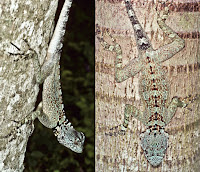Ground Lizards of the genus Tropidurus are found across tropical and subtropical South America. They are ground dwelling Iguanas, favouring open habitats, closely related to the Marine Iguanas of the Galapagos Islands. The group are quite variable, with Lizards with a wide range of sized placed within the genus, and many species showing a wide range of colours. These Lizards tend to be sexually dimorphic (males and females are not the same), with the sexes having different markings in most species and males usually larger than the females.
In a paper published in the American Museum Novitates on 20 February, André Carvalho of the Richard Gilder Graduate School and Division of Vertebrate Zoology (Herpetology) at the American Museum of Natural History, Marco Sena of the Departamento de Zoologia at the Universidade de São Paulo, Pedro Peloso, also of the Division of Vertebrate Zoology (Herpetology) at the American Museum of Natural History and of the Museu Paraense Emílio Goeldi, Fabio Machado of the Departamento de Genética e Biologia Evolutiva at the Universidade de São Paulo, Rachel Montesinos, also of the Departamento de Zoologia at the Universidade de São Paulo, Hélio Silva of the Departamento de Biologia Animal at the Universidade Federal Rural do Rio de Janeiro, Gwyneth Campbell, again of the Division of Vertebrate Zoology (Herpetology) at the American Museum of Natural History and Miguel Rodrigues, again of the Departamento de Zoologia at the Universidade de São Paulo, describe a new species of Tropidurus from the caatinga drylands of Bahia State in Brazil.
The new species is named Tropidurus sertanejo, 'sertanejo' being a Portuguese word meaning 'rural' which is applied in particular to people from the sertão, the dry caatinga areas of northeastern Brazil. The species is described from 25 specimens (five adult males, five adult females and fifteen juveniles) collected from two sites, one in the Reserva Particular do Patrimônio Natural Fazenda Pé da Serra in the Municipality of Ibotirama and the second within the Municipality of Caetité. The Lizards are light brown in colour with pale salmon spots, a lighter underside and a bronze sheen on the head. The species is small compared to most other members of the genus, with adult males ranging from 166.4-197.9 mm in length and adult females from 138.9-147.9 mm in length.
Female specimen of Tropidurus sertanejo from the Reserva Particular do Patrimônio Natural Fazenda Pé da Serra, Serra do Arame. Carvalho et al. (2016).
See also...
 Babibasiliscus alxi: A Casquehead Lizard from the Early Eocene of Wyoming. Casquehead Lizards, Corytophanidae,
are a group of Iguanid Lizards found from the tropical forests of southern Mexico,
through Central America to the northwest of South America. They belong to a
group of Iguanians, the Pleurodonta, found today...
Babibasiliscus alxi: A Casquehead Lizard from the Early Eocene of Wyoming. Casquehead Lizards, Corytophanidae,
are a group of Iguanid Lizards found from the tropical forests of southern Mexico,
through Central America to the northwest of South America. They belong to a
group of Iguanians, the Pleurodonta, found today... A new species of Twig Anole from Panama. Anoles are small Iguanid Lizards found in the Southern United States, Mexico, Central America and the Caribbean. Twig Anoles, Norops spp.,
form a distinct cluster of medium sized Anole Lizard species within the genus Norops. There are currently eight...
A new species of Twig Anole from Panama. Anoles are small Iguanid Lizards found in the Southern United States, Mexico, Central America and the Caribbean. Twig Anoles, Norops spp.,
form a distinct cluster of medium sized Anole Lizard species within the genus Norops. There are currently eight... Four new species of Treerunner from northern South America. Treerunners of the genus Plicaare Iguanid Lizards found in South America east of the Andes. They are medium
sized, conspicuous Lizards that are active in the daytime, living in small
colonies on rock outcrops or trees, and therefore are well represented in
museum collections, as they tend to attract the attention of...
Four new species of Treerunner from northern South America. Treerunners of the genus Plicaare Iguanid Lizards found in South America east of the Andes. They are medium
sized, conspicuous Lizards that are active in the daytime, living in small
colonies on rock outcrops or trees, and therefore are well represented in
museum collections, as they tend to attract the attention of...
Follow Sciency Thoughts on Facebook.

